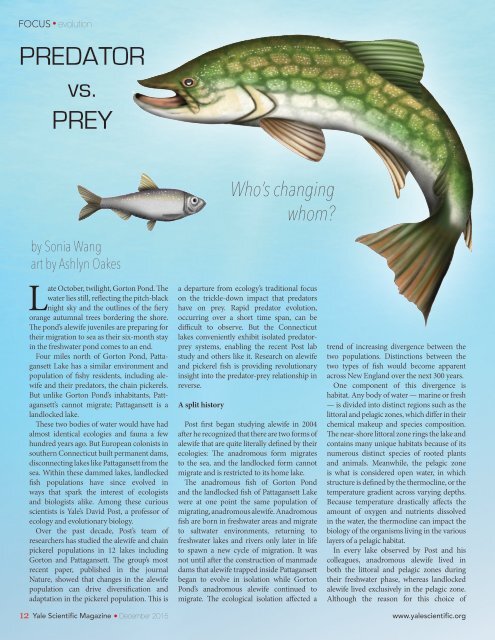YSM Issue 89.1
You also want an ePaper? Increase the reach of your titles
YUMPU automatically turns print PDFs into web optimized ePapers that Google loves.
FOCUS<br />
evolution<br />
PREDATOR<br />
vs.<br />
PREY<br />
Who’s changing<br />
whom?<br />
by Sonia Wang<br />
art by Ashlyn Oakes<br />
Late October, twilight, Gorton Pond. The<br />
water lies still, reflecting the pitch-black<br />
night sky and the outlines of the fiery<br />
orange autumnal trees bordering the shore.<br />
The pond’s alewife juveniles are preparing for<br />
their migration to sea as their six-month stay<br />
in the freshwater pond comes to an end.<br />
Four miles north of Gorton Pond, Pattagansett<br />
Lake has a similar environment and<br />
population of fishy residents, including alewife<br />
and their predators, the chain pickerels.<br />
But unlike Gorton Pond’s inhabitants, Pattagansett’s<br />
cannot migrate; Pattagansett is a<br />
landlocked lake.<br />
These two bodies of water would have had<br />
almost identical ecologies and fauna a few<br />
hundred years ago. But European colonists in<br />
southern Connecticut built permanent dams,<br />
disconnecting lakes like Pattagansett from the<br />
sea. Within these dammed lakes, landlocked<br />
fish populations have since evolved in<br />
ways that spark the interest of ecologists<br />
and biologists alike. Among these curious<br />
scientists is Yale’s David Post, a professor of<br />
ecology and evolutionary biology.<br />
Over the past decade, Post’s team of<br />
researchers has studied the alewife and chain<br />
pickerel populations in 12 lakes including<br />
Gorton and Pattagansett. The group’s most<br />
recent paper, published in the journal<br />
Nature, showed that changes in the alewife<br />
population can drive diversification and<br />
adaptation in the pickerel population. This is<br />
a departure from ecology’s traditional focus<br />
on the trickle-down impact that predators<br />
have on prey. Rapid predator evolution,<br />
occurring over a short time span, can be<br />
difficult to observe. But the Connecticut<br />
lakes conveniently exhibit isolated predatorprey<br />
systems, enabling the recent Post lab<br />
study and others like it. Research on alewife<br />
and pickerel fish is providing revolutionary<br />
insight into the predator-prey relationship in<br />
reverse.<br />
A split history<br />
Post first began studying alewife in 2004<br />
after he recognized that there are two forms of<br />
alewife that are quite literally defined by their<br />
ecologies: The anadromous form migrates<br />
to the sea, and the landlocked form cannot<br />
migrate and is restricted to its home lake.<br />
The anadromous fish of Gorton Pond<br />
and the landlocked fish of Pattagansett Lake<br />
were at one point the same population of<br />
migrating, anadromous alewife. Anadromous<br />
fish are born in freshwater areas and migrate<br />
to saltwater environments, returning to<br />
freshwater lakes and rivers only later in life<br />
to spawn a new cycle of migration. It was<br />
not until after the construction of manmade<br />
dams that alewife trapped inside Pattagansett<br />
began to evolve in isolation while Gorton<br />
Pond’s anadromous alewife continued to<br />
migrate. The ecological isolation affected a<br />
trend of increasing divergence between the<br />
two populations. Distinctions between the<br />
two types of fish would become apparent<br />
across New England over the next 300 years.<br />
One component of this divergence is<br />
habitat. Any body of water — marine or fresh<br />
— is divided into distinct regions such as the<br />
littoral and pelagic zones, which differ in their<br />
chemical makeup and species composition.<br />
The near-shore littoral zone rings the lake and<br />
contains many unique habitats because of its<br />
numerous distinct species of rooted plants<br />
and animals. Meanwhile, the pelagic zone<br />
is what is considered open water, in which<br />
structure is defined by the thermocline, or the<br />
temperature gradient across varying depths.<br />
Because temperature drastically affects the<br />
amount of oxygen and nutrients dissolved<br />
in the water, the thermocline can impact the<br />
biology of the organisms living in the various<br />
layers of a pelagic habitat.<br />
In every lake observed by Post and his<br />
colleagues, anadromous alewife lived in<br />
both the littoral and pelagic zones during<br />
their freshwater phase, whereas landlocked<br />
alewife lived exclusively in the pelagic zone.<br />
Although the reason for this choice of<br />
12 Yale Scientific Magazine December 2015 www.yalescientific.org


















